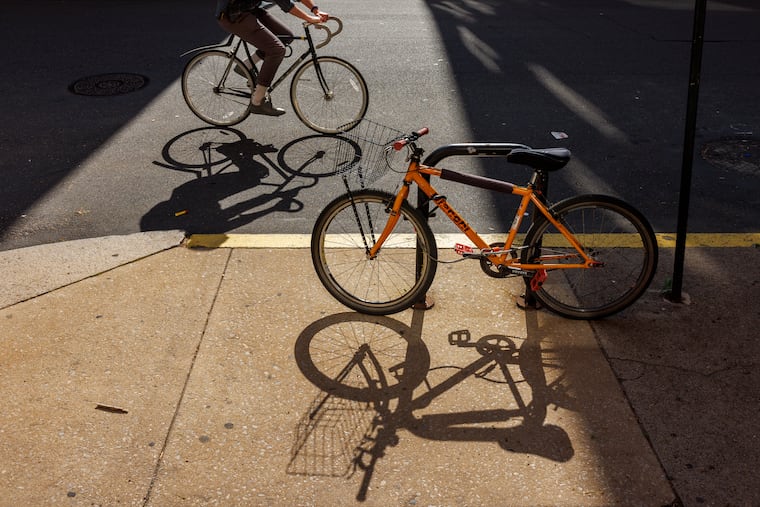What to look for in a bike shop when getting ready to hit the road
The most important factor in choosing a bicycle is simply how it feels when you ride it. Delaware Valley Consumers’ Checkbook’s bike shop ratings help make it easier when buying a bike.

Bikes aren’t just for weekend rides and recreation anymore. Dedicated bicycle lanes, two-wheel-friendly public transit, and a push toward greener lifestyles mean people are increasingly likely to pedal to work or to run errands.
But with so many choices — road, hybrid, mountain — it’s hard to know how to get rolling.
If you want to buy a bike but don’t know where to start, or need repairs for a bike you already own, nonprofit Delaware Valley Consumers’ Checkbook’s ratings of area bike shops will help you track down shops that will make things easy.
Until Sept. 5, Checkbook is offering free access to its ratings of area bike shops to Inquirer readers here.
Bike models come in a range of styles — mountain, road, commuter, touring, cruisers, folding, electric assist — although many models mix and match features of several types.
To narrow your choices, think about how you will use your wheels. Will you run errands, commute, work out, compete? How often will you ride? Will you be riding on smooth roads, potholed city streets, off-road trails? How hilly will the terrain be? Do you have a need for speed?
In general, the more you plan to ride and compete, the more you’ll pay.
Good shops will take the time to fit you carefully, checking factors like frame height, the angle of your legs when pedaling, reach to the handlebars, and handlebar width.
Take a test ride
The most important factor in choosing a bike is simply how it feels when you ride it. Don’t purchase a bike until you’ve taken test rides on several.
For each bike you test, have the store’s salesperson fit you properly. Then observe the smoothness of the ride, the bike’s responsiveness, how comfortable your body feels, the bike’s stability, and how easy it is to control, shift, and brake.
Tell the salespeople what you like and dislike and let them make adjustments or suggest another bike that may suit you better.
Test several bikes in a wide price range. You may find that you can get a thoroughly satisfactory bike for much less than you expected.
Assembly matters
When you’re ready to buy, make sure the store will do a high-quality job of assembling your bike. Retailers are responsible for final assembly and adjustment. When bikes arrive from the factory, some components are not yet attached.
If shop mechanics do no more than slap on the remaining parts, the bike won’t work: Brake pads might not contact rims, for example, and you might not be able to shift into all the gears.
Any shop will assemble and adjust the bike so you can ride out using all the gears; that typically takes about 45 minutes. But a great shop will do much more — possibly spending two to four hours on assembly.
Almost all bike shops offer a period of free adjustments after sales. Many offer free adjustments for the life of the bicycle, while others limit them to one year, six months, or less.
Price comparison
Prices for new bicycles change little from store to store, and you won’t find big savings by buying online. Because bike manufacturers maintain strict pricing controls over retailers, even a $25 difference for major name brands is rare.
Especially since there’s no price advantage to buying bikes online, it’s best to purchase from a local shop for the expertise of their salespeople and mechanics for fitting and adjustments.
Because major manufacturers don’t allow online-only stores to sell bikes, even if you do buy online, you’ll just end up getting redirected to a local store for purchase and assembly. (For example, if you select and buy a bike on Trek’s website, your sale will be finalized by one of its local dealers.)
On the other hand, the market for bike components and accessories — ranging from handlebars to clothing to car-top carriers — is less stringent, with some stores charging half as much as their competition for a particular item. You’ll find even lower prices for accessories online.
Checkbook’s undercover shoppers also found very large price differences for bike repairs. For example, for a basic tune-up for a Giant TCR Advanced Pro 1 road bike, shops quoted prices ranging from $50 to $179. And shops quoted prices ranging from $20 to $90 to install customer-supplied tubeless tires on a Cannondale Habit Carbon 3 trail bike.
Delaware Valley Consumers’ Checkbook magazine and Checkbook.org is a nonprofit organization with a mission to help consumers get the best service and lowest prices. We are supported by consumers and take no money from the service providers we evaluate.